The Front Range Passenger Rail Project is asking for feedback from residents of Longmont and other Front Range cities on what they would like to see in a possible commuter rail line.
The project — a joint effort of the Passenger Rail Commission and the Colorado Department of Transportation — is exploring rail service that would run 180 miles from Fort Collins to Pueblo. The goal is to put a funding proposal on the 2022 ballot, with construction tentatively planned for 2042. An online meeting available through month’s end is gathering feedback on specifics of such a service, including how often people would use a commuter rail line, why they would use it and how often they would like the train to stop.
“I think this Front Range passenger rail is a very good option for Longmont residents,” said Phil Greenwald, transportation planning manager for the city of Longmont. “The fact that there’s more than one regional entity working on this, that’s given us some hope that we can see commuter rail in the next 20 years.”
The rail commission has been working with the Colorado Department of Transportation and cities along the Interstate 25 corridor to pave a path to a Front Range intercity rail system. The Regional Transportation District’s FasTracks system, for which voters approved a .4% sales tax in 2004, had a similar goal. However, full completion of the rail line — originally slated for 2017 — has continually been delayed, with RTD now estimating the 35-mile Northwest Rail line from Longmont to Denver won’t be complete until 2032 at earliest, or as late as 2050, depending on possible additional funding from voter-approved bonds and/or tax increases
Front Range Passenger Rail would have a much broader reach, Greenwald said.
“The hope is that we get the rail one way or another,” he said.
A benefit of having a rail system, said CDOT spokesman Tim Hoover, would be less traffic along I-25 and in cities such as Longmont. During the current coronavirus pandemic, traffic along highways has been noticeably lighter, Hoover said, but that doesn’t take away the long-term need for a train.
“When the pandemic goes away, highways will fill up again,” Hoover said. “We cannot build our way out of congestion.”
Longmont has revamped its focus on road infrastructure and bus transit in recent years, Greenwald said, but congestion is an issue that won’t go away on its own.
“You can’t just keep building lanes and lanes of highway,” Greenwald said, adding he hopes the bus hub on First Avenue and Main Street will become a convenient place for residents to catch a train, bus or taxi to wherever they need to go without having to drive far.
There are still no firm plans for the rail line in terms of funding, where the train would stop or how often it would stop. When the time comes for a discussion about funding, the cost for the project is sure to be in the billions, Hoover said. For now, the rail commission is using the online meeting to ask for residents’ help in the planning process, which is serving as a substitute for an in-person meeting or series of meetings.
The survey has received over 6,000 responses, said project director Randy Grauberger. Anyone interested in participating in the online meeting can do so here.
“The more people that get excited about it, the more possibility there is for funding,” Greenwald said. “I’m just hoping people go out and give some positive feedback about what they’d like to see.”



